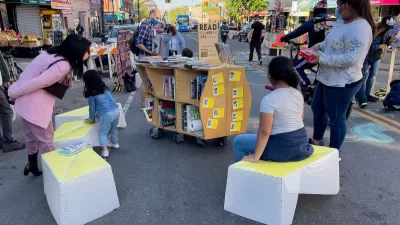Baltimore has a lot of bold ideas for changing the face of the city. While we wait for them to happen, why not implement some simple solutions for making the city more livable, proposes Mark R. Brown, AICP.
Brown suggests six solutions that Baltimore, or any city for that matter, "can do right now to make people say, 'Hey, this place is alright'." His list includes: low cost transit improvements, 20 mph neighborhood zones, complete streets, small public plazas, and street art (which as the video below shows, it already does quite well).
The final element - positive street life, says Brown, is a result of the rest. "Getting off the train from DC into downtown Baltimore is disheartening and a buzz kill. Aside from the sorry state of Penn Station, most of this has to do with how abandoned our streets are, even during lunch and dinner hours. Streets are people’s first impression of a city, and when they’re filled solely with cars rushing by on wide one way streets at 45mph, it says something negative about our city. Go to NYC. Go to Philly. Go to DC or even parts of Pittsburgh and see how their streets are also outdoor performance theaters, playgrounds, cultural conduits, window shopping opportunities, and bicycle skyways. A quality street does more than one thing well. A street that does many things well becomes magical."
FULL STORY: Ways We Can Make Baltimore More Livable Right Now

Americans May Be Stuck — But Why?
Americans are moving a lot less than they once did, and that is a problem. While Yoni Applebaum, in his highly-publicized article Stuck, gets the reasons badly wrong, it's still important to ask: why are we moving so much less than before?

Using Old Oil and Gas Wells for Green Energy Storage
Penn State researchers have found that repurposing abandoned oil and gas wells for geothermal-assisted compressed-air energy storage can boost efficiency, reduce environmental risks, and support clean energy and job transitions.

Placekeeping: Setting a New Precedent for City Planners
How a preservation-based approach to redevelopment and urban design can prevent displacement and honor legacy communities.

San Francisco’s Muni Ridership Grew in 2024
The system saw its highest ridership since before the Covid-19 pandemic, but faces a severe budget shortage in the coming year.

Colorado Lawmakers Move to Protect BRT Funding
In the face of potential federal funding cuts, CDOT leaders reasserted their commitment to planned bus rapid transit projects.

Safe Streets Funding in Jeopardy
The Trump administration is specifically targeting bike infrastructure and other road safety projects in its funding cuts.
Urban Design for Planners 1: Software Tools
This six-course series explores essential urban design concepts using open source software and equips planners with the tools they need to participate fully in the urban design process.
Planning for Universal Design
Learn the tools for implementing Universal Design in planning regulations.
Heyer Gruel & Associates PA
City of Moreno Valley
Institute for Housing and Urban Development Studies (IHS)
City of Grandview
Harvard GSD Executive Education
Salt Lake City
NYU Wagner Graduate School of Public Service
City of Cambridge, Maryland





























